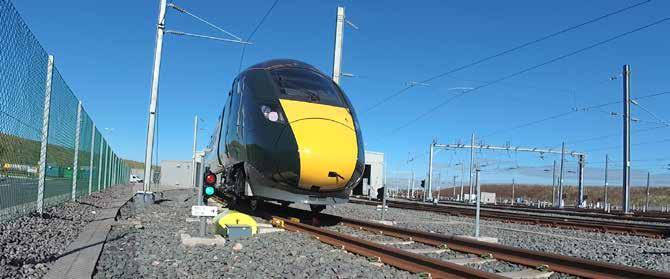e e g h h allen c t r a g h e c n s i t t s e r e n co e c i M atio m e c d fi ri a t c c a ele h g u o r th
72
FEATURE
T
he UK railway industry has been much criticised for the excessive cost of its electrification projects. Of course, not all projects run over budget, and sometimes, even then, the overrun has been caused by factors outside of the industry’s direct control. However, the criticism has focussed minds and resulted in several industry initiatives. One was the Railway Industry Association’s Electrification Cost Challenge Report. Another was a pair of research projects promoted by the University of Sheffield, Furrer+Frey and Network Rail. After four years, two PhDs have been completed, both focusing on different areas of costefficient electrification and improved reliability. The University of Sheffield, Furrer+Frey and Network Rail are all members of the UK Rail Research and Innovation Network (UKRRIN). The research demonstrates that collaboration between universities and industry can play a vital role in bringing innovation to Britain’s railway. Ultimately, the work shows how engineering research can help underpin electrification of the UK’s rail network, driving innovation and improving service reliability for passengers. The two pieces of research, undertaken by Sam Hayes and Özgün Sunar from the University’s Department of Mechanical Engineering, were both supported by Furrer+Frey and Network Rail to focus on cost-efficient electrification of the UK rail network. They were jointly funded by the University of Sheffield, Furrer+Frey and the European Union, as part of programmes to improve research collaboration with the railway industry. Professor David Fletcher, head of the research group at Sheffield, said: “The engagement with Furrer+Frey has been
Rail Engineer | Issue 188 | Jan-Feb 2021
really great in funding and steering these research projects. Their expertise has ensured the research stayed focused on industry needs, ensuring impact from the academic input of our PhD students.”
Wind, speed and slope The first PhD, undertaken by Sam Haye with the support of Prof David Fletcher and Furrer+Frey’s Katherine Chan, examined the effect of wind, train speed and gradient with the aim of avoiding the need for bridge reconstruction on future electrification projects. Bridge reconstruction has been a key driver in increasing electrification costs, so reducing the need for these reconstructions is key to reducing costs, as highlighted in RIA’s Electrification Cost Challenge. Performance of the wires was recorded, using both large-scale wind tunnels and computational fluid dynamics, to create a digital twin of wiring geometry. This digital twin was then validated with real-world testing at Network Rail’s Rail Innovation and Development Centre (RIDC) test track at Old Dalby, near Melton Mowbray in Leicestershire. The researcher looked at the maintenance impact of steeper gradients in order to determine whether the need to reconstruct bridges could be avoided in future.
Engineering director at Furrer+Frey, Rob Daffern, said: “I studied at The University of Sheffield, so to be working with cutting edge research back at Sheffield has been tremendous. The whole industry is focused on reducing costs and research is key.”
Improving reliability The second PhD project was undertaken by Özgün Sunar, with the support of Prof David Fletcher and industrial supervision by Chris Bryan of HS2. The focus of this research was to improve the reliability of overhead line electrification equipment, when shortcircuits and arcing occur. The research used both modelling and mechanical/electrical testing to establish intervention points and understand when maintenance is needed, prior to service-interrupting failures. The research also trialled innovative new conductor materials. The ultimate aim was to improve the performance of electrification and enhance reliability by preventing failures. Director of Furrer+Frey Noel Dolphin said: “We’re proud to be supporting decarbonisation through electrification. Research and study are one of the keys to making electrification cost efficient. “However, as the Railway Industry Association’s Electrification Cost Challenge Report has shown, we need to remember that implementing a rolling programme of electrification would have the biggest impact on costs. By reducing costs and improving reliability, we make this business case stronger.”













